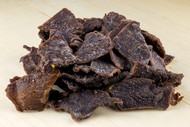Spotting and Preventing Mold on Beef Jerky
Sep 9th 2024
Spotting and Preventing Mold on Beef Jerky
Beef jerky is a popular snack known for its savory flavor and long shelf life due to its dried nature. However, despite its durability, jerky can still fall victim to mold growth. This guide will help you understand why mold grows on beef jerky, how to identify it, the risks associated with consuming moldy jerky, and how to prevent mold growth.
In this guide, we'll talk about mold on beef jerky. It explains the reasons behind its occurrence and how to identify it. It also highlights the risks associated with consuming moldy beef jerky and provides tips on preventing its growth.
Why Does Mold Grow on Beef Jerky?
Mold, a type of fungus, thrives in warm and damp environments. It can affect various food items, including beef jerky. The primary causes of mold growth on jerky include:
- Improper storage: Exposure to humidity or moisture can lead to mold growth over time.
- Contamination during preparation: When making homemade jerky, mold spores can be introduced if the environment or tools aren't properly sanitized.
Recognizing Mold on Your Beef Jerky
Recognizing the signs of moldy beef jerky is essential to ensure you do not consume a potentially harmful food item. To prevent consuming potentially harmful jerky, look for these signs of mold:
- Color changes: Look for green, white, or blue discolored spots that differ from the jerky's natural color.
- Furry texture: Mold often appears as fuzzy or furry patches on the jerky's surface.
- Off smell: Moldy jerky may emit a musty, sour, or unusual odor.
- Altered taste: While not recommended, an off or strange taste can indicate mold presence.
Eat Moldy Jerky?
Eating moldy beef jerky can lead to various health issues. While some molds are benign, others produce harmful substances known as mycotoxins. These toxins can lead to allergic reactions, respiratory distress, and in severe cases, can be toxic. Consequently, it's always safer to discard any beef jerky that you suspect may be moldy, rather than risk your health.
Effective Measures to Prevent Mold on Beef Jerky
Thankfully, taking steps to prevent mold growth on beef jerky is fairly straightforward and mostly involves correct preparation, storage, and handling. Follow these steps to prevent mold growth on your beef jerky:
- Proper preparation:
- Use clean, sanitized tools and equipment when making homemade jerky.
- Ensure the jerky is thoroughly dried before storage.
- Correct storage:
- Keep jerky in a cool, dry place.
- Use airtight containers or vacuum-sealed bags to limit air and moisture exposure.
- Consider refrigeration in humid climates for extended shelf life.
- Timely consumption:
- Eat jerky within the suggested timeframe on the packaging.
- Avoid consuming jerky past its expiration date.
- Proper handling:
- Always handle jerky with clean hands or utensils to prevent contamination.
- Check packaging integrity:
- Ensure the packaging is intact before purchase to avoid exposure to air and moisture.
Conclusion
While finding mold on your beloved beef jerky can be disheartening, understanding the cause, identifying the signs early, and knowing how to prevent its growth can safeguard both your snack and your health. Always err on the side of caution—if you're uncertain about whether your beef jerky has mold, it's safer to dispose of it rather than risk health complications. Stay vigilant, store your jerky correctly, and continue enjoying this delightful snack in a safe and health-conscious manner.

